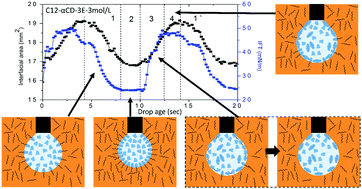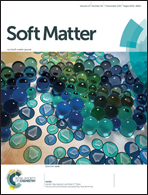Interfacial rheological behaviors of inclusion complexes of cyclodextrin and alkanes
Abstract
The transformation of cyclodextrins (CDs) and alkanes from separated monomers to inclusion complexes at the interface is illustrated by analyzing the evolution of interfacial tension along with the variation of interfacial area for an oscillating drop. Amphiphilic intermediates are formed by threading one CD molecule on one alkane molecule at the oil/aqueous interface. After that, the amphiphilic intermediates transform into non-amphiphilic supramolecules which further assemble through hydrogen bonding at the oil/aqueous interface to generate a rigid network. With the accumulation of supramolecules at the interface, microcrystals are formed at the interface. The supramolecules of dodecane@2α-CD grow into microrods which form an unconsolidated shell and gradually cover the drop. However, the microcrystals of dodecane@2β-CD are significantly smaller which fabricate into skin-like films at the interface. The amphiphilic intermediates during the transformation increase the feasibility of self-emulsification and the skin-like films enhance the stability of the emulsion. With these unique properties, CDs can be promising for application in hydrophobic drug delivery, food industry and enhanced oil recovery.



 Please wait while we load your content...
Please wait while we load your content...